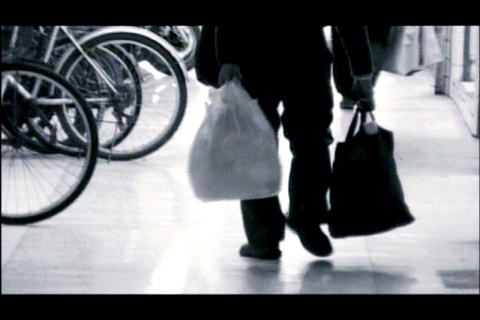In the winter of 2003, a filmmaker named Thomas Joiret came to Taipei to meet his composer friend Pierre Hujoel who has lived in the city on and off for the past five years. A joint film project quickly evolved and a musical documentary on Taiwan entitled Sarabande was completed one year later, garnering an award at Traces de Vies Documentary Film Festival in the French city of Vic-le-Comte. But what the artist duo truly wanted is for Taiwanese audiences to see the film.
Two years after its completion, the film finds its first local screening venue at PS Cafe in the heart of the young and hip East District. Frequented by artist sorts and young hipsters, the intimate, laid-back cafe extends a warm welcome to the documentary about the island's search for identity with a newly equipped projector.
Shot elegantly in black and white, the filmic pas de deux of Joiret's poetic imagery and Hujoel's lyrical music, swings between the buoyant to the dismal. "When looking at the city from MRT trains, Joiret was fascinated at how a festival scene could quickly change to a bleak view, and he wanted to capture such vibes in the film and my music," said the 27-year-old musician who is completing a master's degree in music composition in Belgium while working as a composer in Taiwan.

PHOTO COURTESY OF PIERRE HUJOEL
It's a familiar backdrop in the works of Charlie Chaplin whom the director adores and Sarabande is structured in a manner akin to a silent film where each passage is punctured by verses written in French. With a solid academic background in architecture, the 29-year-old filmmaker creates a surprisingly mature and well-orchestrated work that weaves a series of sketches of locals' daily lives into a personal commentary on the island's political reality.
"Putting art and politics together always has risks. But after seeing the National Taiwan University's (國立台灣大學) archives on KMT's dictatorship in the island, Joiret decided to give it a shot and made the film," said Hujoel, adding that it is an artist's job to create a personal vision with the material, albeit limited, at hand.
To the Belgian duo, the film's raw material is the daily activities, the faces and the gestures of the island's inhabitants that bear imprints of the country's history and its making. "Joiret knew right away the project had to be shot in black and white since to make a proper portrait of the fully-toned city with color film would require years of study. He would go out shooting footage everyday after noon. Sometimes he waited long hours for something he outlined in the storyboard to happen and sometimes little stories he liked just came across his path. He did it for six months and I will say the film uses only one percent of the total footage shot," Hujoel said.
The end result is an intelligent work graced with acute tenderness to the filmed subjects who were unaware of the non-intrusive camera. Audiences see Taiwan through the director's sober lens. The film closes with a little girl in a white dress piling up dropped fruit at a park, building a future to come.
People who attend the opening screenings tonight can also view a photo exhibition about the film and enjoy light refreshments prepared by the 26-year-old store manager Monica Hsieh (謝孟潔), who said the space is now open to anyone with an artistic vision to share.

May 11 to May 18 The original Taichung Railway Station was long thought to have been completely razed. Opening on May 15, 1905, the one-story wooden structure soon outgrew its purpose and was replaced in 1917 by a grandiose, Western-style station. During construction on the third-generation station in 2017, workers discovered the service pit for the original station’s locomotive depot. A year later, a small wooden building on site was determined by historians to be the first stationmaster’s office, built around 1908. With these findings, the Taichung Railway Station Cultural Park now boasts that it has

Wooden houses wedged between concrete, crumbling brick facades with roofs gaping to the sky, and tiled art deco buildings down narrow alleyways: Taichung Central District’s (中區) aging architecture reveals both the allure and reality of the old downtown. From Indigenous settlement to capital under Qing Dynasty rule through to Japanese colonization, Taichung’s Central District holds a long and layered history. The bygone beauty of its streets once earned it the nickname “Little Kyoto.” Since the late eighties, however, the shifting of economic and government centers westward signaled a gradual decline in the area’s evolving fortunes. With the regeneration of the once

The latest Formosa poll released at the end of last month shows confidence in President William Lai (賴清德) plunged 8.1 percent, while satisfaction with the Lai administration fared worse with a drop of 8.5 percent. Those lacking confidence in Lai jumped by 6 percent and dissatisfaction in his administration spiked up 6.7 percent. Confidence in Lai is still strong at 48.6 percent, compared to 43 percent lacking confidence — but this is his worst result overall since he took office. For the first time, dissatisfaction with his administration surpassed satisfaction, 47.3 to 47.1 percent. Though statistically a tie, for most

In February of this year the Taipei Times reported on the visit of Lienchiang County Commissioner Wang Chung-ming (王忠銘) of the Chinese Nationalist Party (KMT) and a delegation to a lantern festival in Fuzhou’s Mawei District in Fujian Province. “Today, Mawei and Matsu jointly marked the lantern festival,” Wang was quoted as saying, adding that both sides “being of one people,” is a cause for joy. Wang was passing around a common claim of officials of the People’s Republic of China (PRC) and the PRC’s allies and supporters in Taiwan — KMT and the Taiwan People’s Party — and elsewhere: Taiwan and